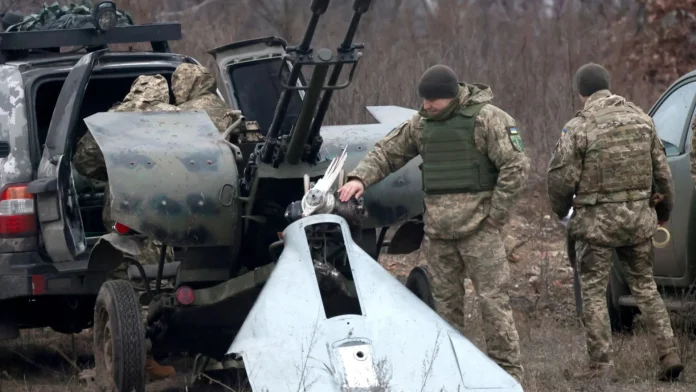Russia Collaborates with China to Develop Drones for Ukraine Conflict: Intelligence Uncovers Troubling Alliance
Russia is reportedly developing long-range drones in China, specifically for deployment in its ongoing conflict with Ukraine. This program involves collaboration between the Russian state-owned company IEMZ Kupol and Chinese specialists, according to European intelligence sources and documents reviewed.
The development of these drones, particularly the Garpiya-3 (G3), raises significant concerns about potential international sanctions and the extent of military support for Moscow amidst its ongoing aggression in Ukraine.
IEMZ Kupol, a subsidiary of the larger Russian weapons manufacturer Almaz-Antey, is leading this ambitious project. The documents indicate that Kupol has successfully developed and tested the Garpiya-3 drone with assistance from Chinese experts.
These drones are designed for long-range attacks, boasting the capability to carry a 50 kg payload over distances exceeding 2,000 kilometers. The purpose of these drones is explicitly tied to Russia’s “special military operation” in Ukraine, a euphemism for its aggressive military actions.
Kupol has reportedly communicated to Russia’s defense ministry that it is capable of mass-producing the G3 drone at a Chinese manufacturing facility. Furthermore, the documents reveal that Kupol has already received several drones manufactured in China, including two G3 models, for further testing and evaluation in Russia.
In response to these revelations, the Chinese foreign ministry has denied any knowledge of such a project. It has emphasized that China maintains strict export controls on unmanned aerial vehicles (UAVs) and has not authorized any such exports to Russia.
While there is no conclusive evidence directly implicating Chinese state entities in the drone production for Russia, experts caution that such a collaboration, if proven, would have far-reaching implications.
Both Russia and Ukraine have been rapidly increasing their production of drones, recognizing their effectiveness in modern combat scenarios. The potential for drones to carry out targeted attacks and gather critical intelligence makes them a valuable asset in the ongoing conflict. This rapid expansion in drone capabilities underscores the strategic importance of unmanned systems in contemporary warfare.
China has consistently denied providing direct military aid to Russia. However, it has faced allegations of supplying dual-use goods—items that can be used for both civilian and military purposes—to Russia. These goods include various components that can be integrated into military technology. The potential partnership between Kupol and Chinese firms could provide Russia with a way to circumvent Western sanctions, allowing it access to advanced technology and manufacturing capabilities through its operations in China.
Beijing, however, faces substantial risks if it is proven to be supporting Russia’s military efforts. The international community, particularly Western nations, has been vigilant in enforcing sanctions against entities aiding Russia’s war efforts. Should evidence emerge of Chinese involvement in producing drones for Russia, it could lead to significant diplomatic and economic repercussions for Beijing.
The ongoing collaboration between Russian and Chinese firms in drone development could signal deeper and more extensive cooperation in the future. This partnership might allow Russia to continue enhancing its military capabilities despite the severe sanctions imposed by Western countries.
Moreover, it could embolden other nations to pursue similar clandestine arrangements to bolster their military assets, undermining global efforts to maintain peace and stability.
This development is particularly alarming given the context of the Ukraine conflict, which has seen significant destruction and loss of life. The introduction of advanced drones capable of carrying substantial payloads over long distances could escalate the conflict further, resulting in even greater devastation.
The international community must closely monitor these developments and take appropriate measures to prevent further escalation and ensure compliance with international sanctions and arms control agreements.
In conclusion, the collaboration between Russia and China in developing long-range drones for use in Ukraine represents a significant and troubling development. The potential for these drones to alter the course of the conflict, coupled with the risks of international sanctions against Beijing, highlights the complexity and danger of this situation.
As the world watches closely, it is imperative that all parties involved adhere to international laws and work towards a peaceful resolution to the ongoing conflict in Ukraine.

